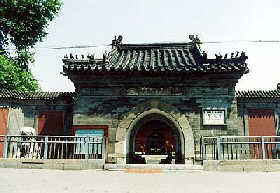The Zhihua Temple is located in the north of the East Michang Road in Dongcheng District, Beijing.
 The Zhihua Temple was formerly the ancestral temple of Wang Zhen, a eunuch of the Rites Supervising Office in the Ming Dynasty (1368-1644). It was first built in the 8th year (1443) of the Zhengtong reign, and Emperor Yingzong gave an imperial name Baoen Zhihua Temple. Wang Zhen (?-1449), who was an eminent eunuch in the Ming Dynasty, used to serve in the Eastern Palace where the crown prince lived, and was especially trusted by the prince. After the prince ascended the throne as Emperor Yingzong, Wang Zhen took charge of the Rites Supervising Office. After the 7th year (1442) of the Zhengtong reign, Wang Zhen became more and more powerful and influential. He not only ordered to build many mansions and expand Buddhist temples, but also discriminated against anybody with different views and made false charges against the loyal court officials. Emperor Yingzong called him Sir instead of his name, and the dukes and marquises respectfully addressed him as Father. In the 14th year (1449) of the Zhengtong reign, the Tumu Incident took place. Wang Zhen and all his relatives were killed. After the emperor restored his throne, he held a memorial ceremony for Wang Zhen in Zhihua Temple and cleaned up the statue in person in the first year (1457) of the Tianshun reign. The temple was repaired several times during the Ming and Qing Dynasties. In the 7th year (1742) under Emperor Qianlong, the statue of Wang Zhen was destroyed and statue of Buddha was built and worshiped.
The Zhihua Temple was formerly the ancestral temple of Wang Zhen, a eunuch of the Rites Supervising Office in the Ming Dynasty (1368-1644). It was first built in the 8th year (1443) of the Zhengtong reign, and Emperor Yingzong gave an imperial name Baoen Zhihua Temple. Wang Zhen (?-1449), who was an eminent eunuch in the Ming Dynasty, used to serve in the Eastern Palace where the crown prince lived, and was especially trusted by the prince. After the prince ascended the throne as Emperor Yingzong, Wang Zhen took charge of the Rites Supervising Office. After the 7th year (1442) of the Zhengtong reign, Wang Zhen became more and more powerful and influential. He not only ordered to build many mansions and expand Buddhist temples, but also discriminated against anybody with different views and made false charges against the loyal court officials. Emperor Yingzong called him Sir instead of his name, and the dukes and marquises respectfully addressed him as Father. In the 14th year (1449) of the Zhengtong reign, the Tumu Incident took place. Wang Zhen and all his relatives were killed. After the emperor restored his throne, he held a memorial ceremony for Wang Zhen in Zhihua Temple and cleaned up the statue in person in the first year (1457) of the Tianshun reign. The temple was repaired several times during the Ming and Qing Dynasties. In the 7th year (1742) under Emperor Qianlong, the statue of Wang Zhen was destroyed and statue of Buddha was built and worshiped.
From the temple gate inwards, there are in turn the Clock Pavilion and the Drum Pavilion, the Gate of Wisdom and Cultivation, the Hall of Wisdom and Cultivation, the Hall of Great Wisdom, the Tibetan Hall, the Hall of Tathagata, the Hall of Great Sorrow and so on. Among them, the Hall of Tathagata is the most exquisite and elegant, which has two storeys and enshrines the Statue of Tathagata. On the upper floor, there are more than 9,000 little niches in the walls, and therefore it is also called Pavilion of Ten-Thousand Buddha. On the top of the bright room inside the pavilion, there are eight exquisitely carved sunk panels with gorgeous decorations and gold foils. The edges of the sunk panels are carved into little palaces, pavilions and shrines, complicatedly decorated. They are rarely seen among the extant ancient structures in China. However from 1930 to 1934, some monks stole and sold them, which are now preserved in the Nelson Museum in United States. The Zhuanlunzai (Wheel Carrier) in the Tibetan Hall is an octagonal wooden structure with a pedestal built of white marble. Engraved on the cabinets are patterns of golden-wing birds in relief, dragon girls, immortals, lions and beasts. These well-designed patterns are exquisite artistic works, showing a lot of imagination.
A wooden version of Tripitaka completed during the reign of Emperor Qianlong was kept in the Zhihua Temple, and it contains 724 sections in more than 7,240 volumes and 1,675 Buddhist sutras. It weighs 400 tons and is one of two wooden versions of Tripitaka in Chinese in the world. The other is the Korean Version of Tripitaka, which is kept in the Haiyin Temple in Korea.
The roofs of the main buildings in the temple are covered with black glazed tiles. Though through several repairs, the main parts of the buildings such as dougong (wooden square blocks inserted between the top of a column and a crossbeam), roof beams and colored paintings still keep the characteristics of the structures in the early Ming Dynasty. It is the most intact complex of temple buildings of the Ming Dynasty in Beijing.
